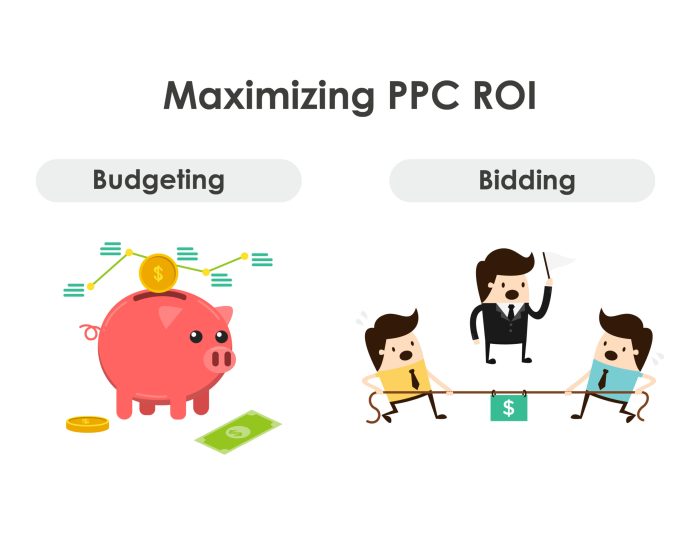Maximizing PPC ROI is all about getting the most bang for your buck in online advertising. From understanding the ins and outs of PPC ROI to optimizing quality scores and budget allocation strategies, this topic dives deep into the world of pay-per-click campaigns. So, buckle up and get ready to take your online advertising game to the next level!
Understanding PPC ROI
In the world of online advertising, understanding PPC ROI is crucial for businesses looking to maximize their marketing efforts and budget.
What is PPC ROI?
PPC ROI, or Pay-Per-Click Return on Investment, measures the effectiveness of a PPC campaign by calculating the revenue generated compared to the amount spent on ads.
- PPC ROI Formula:
(Revenue from PPC Campaign – Cost of PPC Campaign) / Cost of PPC Campaign * 100%
- How it’s Measured: PPC ROI is typically measured in percentages, with a positive ROI indicating a profitable campaign and a negative ROI signaling losses.
Importance of Tracking Conversions
Tracking conversions and attributing them to PPC campaigns is essential for determining the success of advertising efforts and optimizing future strategies.
- Conversion Tracking: By tracking conversions such as online purchases, form submissions, or sign-ups, businesses can accurately assess the impact of PPC ads on driving desired actions.
- Attribution Models: Utilizing attribution models helps in understanding the customer journey and allocating credit to different touchpoints, including PPC campaigns, that lead to conversions.
Maximizing Click-Through Rates (CTR)

To maximize Click-Through Rates (CTR) in PPC campaigns, it is crucial to implement effective strategies that can attract more clicks from your target audience. By optimizing your ad copy and utilizing ad extensions, you can significantly increase CTR and ultimately improve the performance of your campaigns.
One key strategy to increase CTR is to ensure that your ad copy is compelling and relevant to your target audience. By crafting engaging headlines and including relevant s, you can capture the attention of users and entice them to click on your ads. Additionally, using ad extensions such as site links, callouts, and structured snippets can provide users with more information about your business and increase the likelihood of them clicking on your ads.
Different Ad Copy Approaches
- Highlight unique selling points: Showcase what sets your business apart from competitors to attract clicks.
- Include a clear call-to-action: Encourage users to take action by including a compelling CTA in your ad copy.
- Use dynamic insertion: Customize your ad copy to match the user’s search query for a more personalized experience.
Significance of Ad Extensions
Ad extensions play a crucial role in improving CTR by providing users with additional information and options to engage with your ads. They can help increase visibility, provide more context about your offerings, and ultimately drive more clicks to your website.
Optimizing Quality Score: Maximizing PPC ROI

To maximize PPC ROI, it’s crucial to focus on optimizing Quality Score in your advertising campaigns. Quality Score is a metric used by search engines to evaluate the relevance and quality of your ads, s, and landing pages. A higher Quality Score can lead to lower costs and better ad placement, ultimately improving your overall campaign performance.
Factors Influencing Quality Score
- The relevance of your s to your ads and landing pages.
- The click-through rate (CTR) of your ads.
- The quality and relevance of your landing pages.
- The historical performance of your account and campaigns.
- The ad format and extensions used in your ads.
Tips for Improving Quality Score, Maximizing PPC ROI
- Create tightly themed ad groups with relevant s and ad copy.
- Optimize your landing pages for relevance and user experience.
- Improve your ad copy to increase CTR and engagement.
- Regularly review and refine your list to ensure relevance.
- Test different ad formats and extensions to see what works best.
Relationship Between Quality Score, Ad Rank, and Cost Per Click
Quality Score plays a significant role in determining your ad rank and cost per click in PPC advertising. A higher Quality Score can result in a higher ad rank, meaning your ads are more likely to be shown in top positions on the search results page. Additionally, a higher Quality Score can lead to lower costs per click, as search engines reward advertisers with relevant and high-quality ads by offering lower CPCs.
Budget Allocation Strategies
In order to maximize the return on investment (ROI) of your PPC campaigns, it is crucial to have effective budget allocation strategies in place. By strategically distributing your budget across various campaigns, you can ensure that your advertising dollars are being utilized in the most efficient and effective way possible.
Testing budget distribution is key to determining which campaigns are performing well and which ones may need adjustments. By analyzing the performance data of each campaign, you can make informed decisions about where to allocate more budget to maximize ROI.
Different Methods for Allocating Budgets
- Equal Distribution: Allocating an equal amount of budget to each campaign to test their performance.
- Performance-Based Allocation: Adjusting budget allocation based on the performance data of each campaign, investing more in the top-performing campaigns.
- Seasonal Allocation: Adjusting budget allocation based on seasonal trends or peak times for your business.
Importance of Testing Budget Distribution
- Allows you to identify top-performing campaigns and allocate more budget to maximize ROI.
- Helps in identifying underperforming campaigns that may need adjustments or reallocation of budget.
- Ensures that your advertising dollars are being spent effectively and efficiently.
Adjusting Budget Allocation Based on Campaign Performance
- Regularly monitor the performance data of each campaign to identify trends and patterns.
- Based on the data, adjust budget allocation to invest more in campaigns that are driving results.
- Consider reallocating budget from underperforming campaigns to top-performing ones to maximize ROI.
